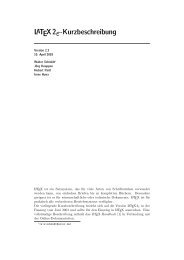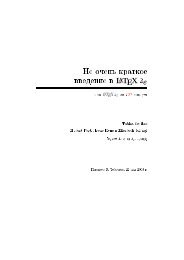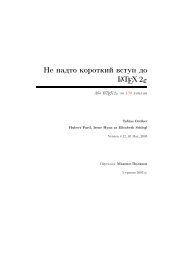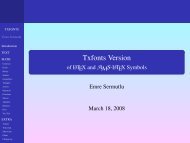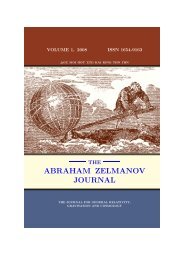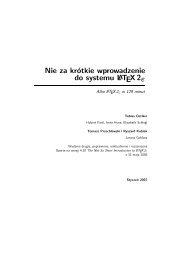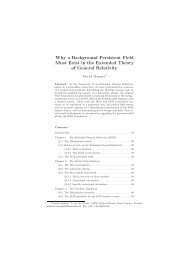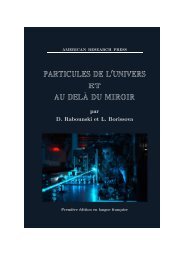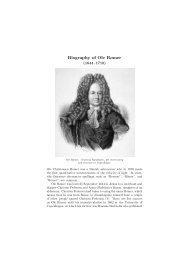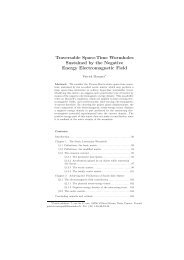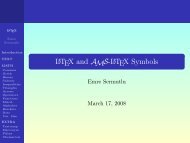1428357676Figure 4: Proof diagram of lightbulb10.mfNow type a test command (\help for help):)*\table*\bye[1]Output written on testfont.dvi (1 page, 1516 bytes).Transcript written on testfont.log.<strong>The</strong> resulting table, stored in testfont.dvi and illustrated in Figure 5, shows every character in the font.To understand how to read the table, note that the character code for “A”—the only character defined bylightbulb10.mf—is 41 in hexadecimal (base 16) and 101 in octal (base 8).Test of lightbulb10 on March 11, 2003 at 1127´0 ´1 ´2 ´3 ´4 ´5 ´6 ´7´10x A´11x˝8 ˝9 ˝A ˝B ˝C ˝D ˝E ˝F˝4xFigure 5: Font table produced by testfont.tex<strong>The</strong> LightBulb10 font is now usable by TEX. L A TEX 2ε, however, needs more information before documentscan use the font. First, we create a font-description file that tells L A TEX 2ε how to map fonts in a given fontfamily and encoding to a particular font in a particular font size. For symbol fonts, this mapping is fairly simple.<strong>Symbol</strong> fonts almost always use the “U” (“Unknown”) font encoding and frequently occur in only one variant:normal weight and non-italicized. <strong>The</strong> filename for a font-description file important; it must be of the form“〈encoding〉〈family〉.fd”, where 〈encoding〉 is the lowercase version of the encoding name (typically “u” forsymbol fonts) and 〈family〉 is the name of the font family. For LightBulb10, let’s call this “bulb”. Figure 6 liststhe contents of ubulb.fd. <strong>The</strong> document “L A TEX 2ε Font Selection” [L A T00] describes \DeclareFontFamilyand \DeclareFontShape in detail, but the gist of ubulb.fd is first to declare a U-encoded version of the bulbfont family and then to specify that a L A TEX 2ε request for a U-encoded version of bulb with a (m)edium fontseries (as opposed to, e.g., bold) and a (n)ormal font shape (as opposed to, e.g., italic) should translate into aTEX request for lightbulb10.tfm mechanically scaled to the current font size.<strong>The</strong> final step is to write a L A TEX 2ε style file that defines a name for each symbol in the font. Becausewe have only one symbol our style file, lightbulb.sty (Figure 7), is rather trivial. Note that instead oftypesetting “A” we could have had \lightbulb typeset “\char65”, “\char"41”, or “\char’101” (respectively,decimal, hexadecimal, and octal character offsets into the font). For a simple, one-character symbol font98
\DeclareFontFamily{U}{bulb}{}\DeclareFontShape{U}{bulb}{m}{n}{ lightbulb10}{}Figure 6: L A TEX 2ε font-description file (ubulb.fd)such as LightBulb10 it would be reasonable to merge ubulb.fd into lightbulb.sty instead of maintainingtwo separate files. In either case, a document need only include “\usepackage{lightbulb}” to make the\lightbulb symbol available.\newcommand{\lightbulb}{{\usefont{U}{bulb}{m}{n}A}}Figure 7: L A TEX 2ε style file (lightbulb.sty)METAFONT normally produces bitmapped fonts. However, it is also possible, with the help of someexternal tools, to produce PostScript Type 1 fonts. <strong>The</strong>se have the advantages of rendering better in Adobe ®Acrobat ® (at least in versions prior to 6.0) and of being more memory-efficient when handled by a PostScriptinterpreter. See http://www.tex.ac.uk/cgi-bin/texfaq2html?label=textrace for pointers to tools that canproduce Type 1 fonts from METAFONT.7.4 Math-mode spacingTerms such as “binary operators”, “relations”, and “punctuation” in Section 3 primarily regard the surroundingspacing. (See the Short Math Guide for L A TEX [Dow00] for a nice exposition on the subject.) To use a symbolfor a different purpose, you can use the TEX commands \mathord, \mathop, \mathbin, \mathrel, \mathopen,\mathclose, and \mathpunct. For example, if you want to use \downarrow as a variable (an “ordinary”symbol) instead of a delimiter, you can write “$3 x + \mathord{\downarrow}$” to get the properly spaced“3x + ↓” rather than the awkward-looking “3x+ ↓”. Similarly, to create a dotted-union symbol (“ ˙∪”) thatspaces like the ordinary set-union symbol (\cup) it must be defined with \mathbin, just as \cup is. Contrast“$A \dot{\cup} B$” (“A ˙∪B”) with “$A \mathbin{\dot{\cup}} B$” (“A ˙∪B”). See <strong>The</strong> TEXbook [Knu86a]for the definitive description of math-mode spacing.<strong>The</strong> purpose of the “log-like symbols” in Tables 120 and 121 is to provide the correct amount of spacingaround and within multiletter function names. Table 284 contrasts the output of the log-like symbols withvarious, naïve alternatives. In addition to spacing, the log-like symbols also handle subscripts properly. Forexample, “\max_{p \in P}” produces “max p∈P ” in text, but “max” as part of a displayed formula.p∈PTable 284: Spacing Around/Within Log-like <strong>Symbol</strong>sL A TEX expressionOutput$r \sin \theta$ r sin θ (best)$r sin \theta$ rsinθ$r \mbox{sin} \theta$ rsinθ$r \mathrm{sin} \theta$ rsinθ<strong>The</strong> amsmath package makes it straightforward to define new log-like symbols:\DeclareMathOperator{\atan}{atan}\DeclareMathOperator*{\lcm}{lcm}<strong>The</strong> difference between \DeclareMathOperator and \DeclareMathOperator* involves the handling of subscripts.With \DeclareMathOperator*, subscripts are written beneath log-like symbols in display style andto the right in text style. This is useful for limit operators (e.g., \lim) and functions that tend to map overa set (e.g., \min). In contrast, \DeclareMathOperator tells TEX that subscripts should always be displayedto the right of the operator, as is common for functions that take a single parameter (e.g., \log and \cos).Table 285 contrasts symbols declared with \DeclareMathOperator and \DeclareMathOperator* in both textstyle ($. . .$) and display style (\[. . .\]). 1111 Note that \displaystyle can be used to force display style within $. . .$ and \textstyle can be used to force text stylewithin \[. . .\].99



